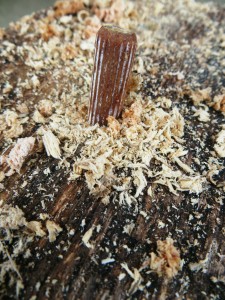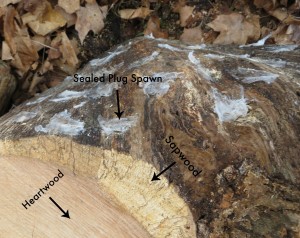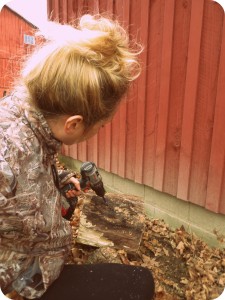After several years of growing mushrooms indoors, I decided to move my mushroom farm outdoors for more space and a higher yield.
Strains and spawn
The first step to growing mushrooms outdoors is choosing a strain of mushroom and a spawn carrier. Supplier Field and Forest offers a dozen strains of mushroom in several carrier options: grain, plug, sawdust, peg and thimble spawn. Their seasonal planting chart at www.fieldforest.net helped me select shiitake plug spawn to overwinter in logs. I chose two varieties of shiitake, cold weather juniper and warm/cool weather WW70, to produce a continuous crop of mushrooms from early spring through fall.
Related: Part I: Growing mushrooms indoors
Logs and stumps
Don’t use diseased or damaged wood to grow mushrooms. Spawn derives nutrition from the sapwood ring between the heartwood and bark. Select logs with a healthy-sized sapwood and small heartwood. Chose logs with three to five-inch diameters, cut to three to four-foot length. Each log will support 30-50 plug spawn. A large stump will hold over 50 plugs.
Inoculation

Use a five-sixteenths drill bit to drill 1.5 inch holes in a diamond pattern around the entire exterior of the log or stump. Do not drill cut surfaces of logs. Pop a plug in each hole and gently hammer it in.

Beeswax, paraffin, cheese wax or specialty plug wax can be used to seal holes. I prefer specialty plug wax because it does not need to be heated before use. Sealing holes protects spawn and maintains moisture. Producers in very dry or very cold climates also seal log ends.
Laying yard
Place logs in a shady, moist and protected area, similar to the natural forest environment in which mushrooms thrive. Do not stack logs like firewood. Instead, choose a proven stacking method: A-frame, lean-to, crib or triangle. I lean my logs at a 45-degree angle to allow exposure to air and moisture.

Although my laying yard is well-protected from winter’s elements, I cover inoculated logs with breathable burlap for added protection. I will uncover the logs in spring when the temperature is consistently above 40 degrees Fahrenheit. By then the logs will have white patches of mycelia growth, foretelling the fungi have successfully overwintered and mushrooms are on the way.
Maintenance
Moisture is rarely a problem in winter, but logs may need to be watered in the summer to prevent drying out. Keeping logs in a protected area with heavy shade helps maintain moisture without irrigation.
Harvest
Time from inoculation to mushroom fruiting can take anywhere from six to 18 months. My shiitake mushrooms will begin fruiting in early spring. I selected cool weather juniper shiitake specifically for their low fruiting temperature of 35 to 55 degrees Fahrenheit. My warm weather WW70 shiitake will fruit late summer/early fall, when the temperature is 50-80 degrees Fahrenheit.
Outdoor logs will produce mushrooms on natural fruiting cycles for up to three years. Outdoor logs require ample downtime for rest and recovery between natural fruiting cycles. To minimize downtime you can bring logs indoors, soak them in water and force fruit every few months. A controlled environment will increase yields substantially.













